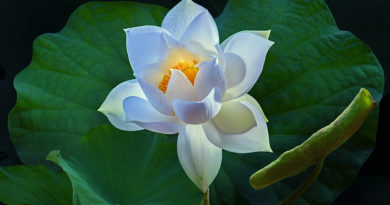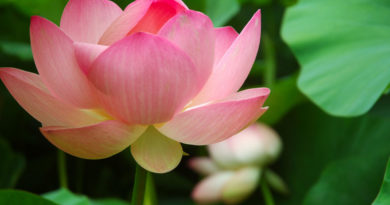THE CONCEPT OF PERSONALITY REVEALED THROUGH THE PANCANIKAYA – PART IV: PANCAKKHANDHA AND INDIVIDUAL PROBLEMS, CHAPTER 1: INDIVIDUAL DESIRE
MAIN CONTENT
THE CONCEPT OF PERSONALITY REVEALED THROUGH THE PANCANIKAYA – PART IV: PANCAKKHANDHA AND INDIVIDUAL PROBLEMS
CHAPTER 1: INDIVIDUAL DESIRE
Mentioning the doubts about the Existence of no-suffering and the desireless way of life, a thought arises in the author’s mind that: just as questions about the Earth and the estimates made by a fish sound very strange to a person, it is so for the questions and estimates made by a person who has not experienced the operation of wisdom and the desireless way of life. That thought reminds him of the search for the truth of desire for things but not for the reasonable answers to those doubts
Lord Buddha’s teaching regards only the truth of suffering (dukkha), the cause of suffering that is desire for sensuality, existence and non-existence (samudaya), the extinction of suffering (nirodha) and the way to the extinction of suffering (magga) as what He taught in His first discourse of “Turning the Wheel of Dhamma” at the Deer Park. In this part of the work, the second Noble Truth is discussed.
As introduced in (II.2.2.), in the beginning, the first people existed were those came into existence from the State of Abhassara Brahm�. They were mind – made, feeding on delight, self luminous, moving through the air, glorious…. No male and female were discriminated. Then, after a short period of time, the greediness of manappeared; then desire for sensuality arose in them. They became more and more greedy, owing to this, their body turned coarser and coarser; the best looking human being was the one who desired for sensuality the least. After that, came the period of time when males developed male sex-organs, females developed female sex-organs, then their passions increased and their body burnt with lust: sexual intercourses appeared. The first intercourses were cursed by the masses; those who made love were thrown dust, ashes, and were not allowed to live together with the masses in villages for two months. When the phenomenon of sexual intercourse became more popular, sexual life were accepted openly by the masses. Human society were formed with its social organization from that time…
The above story about the formation of human society is recorded in the Discourse on “On Knowledge of Beginnings”, Daghanikaya, sutta No 27. It is declared by Lord Buddha Himself through the vision of the Enlightened One. This is reality but not speculation. With regard to that story, sensual and sexual desire is not the basic instinct of human beings: it is but a degradation of human mind when the greediness (lobha) of man is strongly developed by the operation of ignorance (avijja). Nowadays, sexual desire is being developed so strongly that it becomes a very important need of man, and sexual actions are being commercialized openly. This is a big problem to be discussed.
IV.1.1: SENSUAL DESIRE
Sensual desire belongs to craving, which, as defined in (II.1.2.), includes craving for sense pleasures, for existence and for non-existence, or includes six groups called craving for things seen, for things heard, for odours, for tastes, for things tangible and for ideas. Except the sphere of ideas, the first five spheres are called sensual craving.
In the beginning men enjoyed self-delight, the delight arising in their mind. Sensual pleasures came afterwards and became their need, then their crucial need, then appeared as the meaning of human life which controlled men’s mental activities. Since then, men’s sensual desire turned to be the chief cause of a culture called culture of sensuality. This culture, in its turn, has put strong influences on men’s thoughts and feelings and brought up men’s sensual desire. In another aspect of life, being impermanent, sensual pleasures cannot fulfill men’s strong desire. The more men feel unsatisfied with sensual pleasures and sexual pleasures, the more they thirst for them. Now, men’s sensual and sexual desires together with their culture of sensuality make up a new operation of feeling and thinking and force them to regard sensuality and sexuality as basic instincts without seeing the way out. For this operation, Lord Buddha twenty six centuries ago said:
” Monks, I know of no other single form by which a man’s heart is so enslaved as it is by that of a woman. Monks, a woman’s form obsesses a man’s heart. Monks, I know of no other single sound bywhich a man’s heart is so enslaved as it is by the voice of a woman.Monks, a woman’s voice obsesses a man’s heart. Monks, I know of no other single scent… savour… touch by which a man’s heart is so enslaved as it is by the scent, savour, and touch of a woman. Monks, the scent, savour and touch of a woman obsess a man’s heart.
Monks, I know of no other single form, sound, scent, savour and touch by which a woman’s heart is so enslaved as it is by the form, sound, scent, savour and touch of a man. Monks, a woman’s heart is obsessed by these things”. (1)
(“N’aham, bhikkhave, annam ekarupam pi samanupassami yam evam purisassa cittam pariyadaya titthati yathayidam, bhikkhave, itthiruapam.
Itthiruapam, bhikkhave, purisassa cittam pariyadaya titthata ti.
N’aham, bhikkhave, annam ekasaddam pi … ekagandham pi… ekarasam pi .. ekaphotthabbam pi .. samanupassami yam evam purisassa cittam pariyadaya titthati yathayidam, bhikkhave, itthisaddo (itthigandho, itthiraso, itthiphotthabbam ).
N’aham, bhikkhave, annam ekaruapam pi… ekasaddam pi … ekagandham pi … ekarasam pi … ekaphotthabbam pi … samanupassami yam evam itthiya cittam pariyadaya titthati yathayidam, bhikkhave, purisaruapam(purisasaddo, purisagandho, purisaraso, purisaphotthabbam ). Purisaruapam bhikkhave, itthiya cittam pariyadaya titthatati”). (2)
So, females and males are the original causes of sensual and sexual desires of each other. These desires existing in the condition of impermanence, cause their pleasures and sufferings in which nothing sacred or mysterious is present. Human beings from the state of life of no greediness, which is regarded as the wholesome way of life, came to greediness; then from greediness came to sensual and sexual desires which are considered as evil ones. Greediness, as discussed in the operation of Dependent Origination, is the result of the operation of wrong thought – which supposes that a human being has his own self or soul – leading to evil states of mind as Lord Buddha taught:
” Monks, I know not of any other single thing of such power to cause the arising of evil states not yet arisen or the waning of good states already arisen as greediness. In him who is greedy, evil states not yet arisen do arise and good states arisen do wane. Monks, I know not of any other single thing of such power to cause the arising of good states not yet arisen or the waning of evil states already arisen as good states of wanting little”. (3)
(“N’aham, bhikkhave, annam ekadhammam pi samanupassami yena anuppanna va akusala dhamma uppajjanti uppannava kusala dhamma parihayanti yathayidam, bhikkhave, mahicchata.
Mahicchassa, bhikkhave, anuppanna c’eva akusala dhamma uppajjanti uppanna ca kusala dhamma parihayanta ti.
N’aham, bhikkhave, annam ekadhammam pi samanupassami yena anuppanna va kusala dhamma uppajjanti uppanna va akusala dhamma parihayanti yathayidam, bhikkhave, appicchata.
Appicchassa, bhikkhave, anuppanna c’eva kusala dhamma uppajjanti uppanna ca akusala dhamma parihayanta ti”). (4)
A person’s thought that every existing thing has its own self means “I am”, “I was”, “I will be”, “I should be”, or “May I be”, etc. This thought implies the meaning of “craving for existence” therefore Lord Buddha taught there are eighteen thoughts which are haunted by craving concerning the inner self, and eighteen thoughts which are haunted by craving concerning what is eternal to self as follows:
“And of what sort, monks, is craving that ensnares, that floats along, that is far – flung, that clings to one, by which this world is smothered, enveloped, tangled like a ball of thread, covered as with blight, twisted up like a grass – rope, so that it overpasses not the Constant Round (of birth), the Down-fall, the way of woe, the Ruin?
There are eighteen thoughts which are haunted by craving concerning the inner self and eighteen which are haunted by craving concerning what is external to self.Now of what sort are the former?
Monks, when there is the thought: I am, – there come the thoughts: I am in this world: I am thus: I am otherwise: I am not eternal: I am eternal. Should I be: should I be in this world: Should I be thus: Should I be otherwise. May I become: May I become in this world: May I become thus: May I become otherwise. I shall become. I shall become in this world, I shall become thus, I shall become otherwise.
And of what sort, monks, are the eighteen thoughts which are haunted by craving concerning what is external to self?
When there is thought; By this I am, there come the thoughts,
By this, I am in this world, …
By this, I should be: …
By this, May I become: …
By this, I shall become: …” (5)
(“Tanham vo, bhikkhave, desessami jalinimsaritamvisatam visattikam yaya ayam loko uddhasto pariyonadho tantakulakajato gulagundikajato munjababbajabhuto apayamduggatim vinipatam samsaram nativattati, tam sunatha sadhukam manasikarotha bhasissamati. …
Katama, ca, bhikkhave, tanha jalina sarita visata visattika yaya ayam loko uddhasto pariyonaddhotantakulakajato gulagundikajato.. nativattati?
Attharasa kho pan’ imani, bhikkhave, tanhavicaritani ajjhatikassa upadaya, attharasa tanhavicaritani bahirassa upadaya.
Katatamani attharasa tanhavicaritani ajjhattikassa upadaya.
Asmati, bhikkhave, sati, itthasmati hoti, evasmati hoti, annathasmati hoti, asasmati hoti, satasmati hoti, santi hoti…, api ha santi hoti, … bhavissanti hoti, …
Katamani attharasa tanhavicaritaani bahirassa upadaya. Imina asmati, bhikkhave, sati, … imina santi hoti, … imina api ha santi hoti, … imina bhavissanti hoti, …”.) (6)
From the above teaching, a person’s thought is but self thought which is haunted by craving, and is operating as craving. So he is regarded as craving from which sensual and sexual desires arise. On the one hand, the person considers his desire himself and is dipped in the desire and suffering, on the other hand, Lord Buddha shows that that desire is not He, is not his, and is not his self: he should leave it for peace of mind and happiness. The abandonment of desire may happen immediately and effectively, or happen through a process. In the case of abandonment process, the person should know which sensual desire to be responded to, and how much of its requirement to be responded. In doing thus, he can control his mind from being embued with worries, and recognize clearly that the fulfilment of his sensual desire and his happiness are two separate things. With this attitude of life he enters into daily life and faces to the objects of sensual desire with a great care.
For things seen, such as forms, sights, cars, houses, clothes, …, and even money, he cannot keep desiring for, because they are so attractive and necessary to him. Facing those things is facing two aspects of their existence: One is their satisfaction, another is their danger caused by impermanence which will lead him to suffering.
For things heard, such as music, the voice and sound of his opposite sex…, they may allure him and make him lose his self – control to fall into troubles. These things also have two faces; one is their satisfaction, another is their danger caused by the change which will bring him unsatisfaction
For good smells, good tastes and touches, they also are very attractive: They may give him their satisfaction that makes his mind burnt with thirst for pleasures: This is one side, the other side is their danger caused by their change and transcience that will lead him to sorrows, pain, lamentation, grief and woes.
According to the teaching of Lord Buddha, understanding an existing thing means understanding its satisfaction, its danger and the way to come out of its bond. So, understanding sensual desire is understanding the satisfaction of form, sound, smell, taste, and touch of males and females, their danger, and the way to come out of one’s attachment to them which is the Eightfold Noble Path led by “right view” and “right thought”. It is not the problem to come to some definition of sensual desire or to fulfill one’s sensual desire.
Among sensual desires, sexual desires are the strongest that need to be discussed separately.
- 1.2. SEXUAL DESIRE
With regard to the story on “On Knowledge of Beginnings” (Aggannasuttam) as mentioned, sexual desire is but human beings’ greediness developed at its high level. This greediness influences strongly on men’s mental, oral and bodily activities which are called volitional actions (or Kamma). It is grasped by the intention (or volition) of a person, so it may be controlled or destroyed by that intention. For a Buddhist monk whose intention is to realize a Brahmacariya life sexual desire is being abandoned thoroughly. For a Buddhist layman or laywoman, whose intention is to live a family life in sexual pleasure, sexual desire is available, except sexual misconduct, as the following teaching says:
” What are the four defilements of action that are abandoned? Taking life is one, taking what is not given is one, sexual misconduct is one, lying speech is one. These are the four defilements of action that he abandons. Thus Lord Buddha spoke”. (7)
(” Katam’ assa cattaro kamma-kilesa pahana honti? Panatipato kho, gahapati-putta, kamma-kileso, adinnadanam kamma-kileso, kamesu micchacaro kamma-kileso, musavado kamma-kileso. Imassa cattaro kamma- kilesa pahana honta ti. Idamavoca Bhagava”.) (8)
Regardless of living a Brahmacariya life or a family life, a Buddhist should realize the truth of sexual desire to deal with it . It is a desire of a very sweet feeling caused by a touch of sex – organs, so it belongs to the operation of “ignorance” leading to suffering. In other words, to the regard of wisdom it is suffering. No mystery exists in it, except “ignorance”. The change of life and of the sex itself is its aspect of danger, including some terrifying problems caused by it. The way to come out of its dangers is to come to the regard of wisdom and the operation of wisdom. Understanding sexual desire is such a regard of wisdom to be brought up. A person’s regard to sexual problems and sexual desires is very important. From this regard his psychological reactions and his behaviours towards them arise: enjoying them? Controlling them? or abandoning them? and how? – So, one’s behaviours towards sexual problems are not the “I”, the “Mine” or the “My self”. They are not either any major part of what is called personality at all. They exist as a dream which is present when ignorance is present, and absent from man’s life when ignorance is absent.
IV.1.3: DESIRE FOR EXISTENCE
For those who are tired of desire for sensual pleasures, they come to the desire for existence called rupatanha or bhavatanha in Pali. This is a higher and more delicate level of desire, i.e., desire for a state of mind abiding in the First Meditation (Jhana), the Second Meditation, the Third or the Fourth Meditation. In thefirst meditation, their mind abides in initial thought (vitakka), sustained thought (vicara), rapture (pati), joy (sukha) and one – pointedness of mind (ekaggata); In the second one, their mind abides in rapture, joy and one pointedness of mind; in the third one, in joy and one pointedness of mind, and in the fourth, in one-pointedness of mind.
When engaging in sensual pleasures, a person wishes that may the object causing his feeling of pleasure be permanent: this is a manifestation of “desire for existence”.
Such is the arising or existing of “desire for existence”! Such is the satisfaction of “desire for existence!”
Impermanence is the aspect of suffering “desire for existence” and “right view”, “right thought” which sees the truth of all above mentioned things open the way to come out of their bonds. Meditative thoughts are only mental activities belonging to aggregate of activities which is suffering, therefore a number of human beings may leave “desire for existence” for “desire for non – existence”.
IV.1.4. DESIRE FOR NON-EXISTENCE
Those who are tired of sensual desire and desire for existence tend to come to desire for non – existence or annihilation, because for them if existence is suffering, non – existence, in their belief, will be happy. And, psychologically when a person is tired of existence, he automatically thirsts for non-existence or annihilation.
In reality, desire for anything is but a desire belonging to the aggregate of activities, and so it will leada person to suffering of some state in the Round of Rebirth – That state of mind is appropriate to Aruapa states.
The satisfaction, the danger and the “way out” of the activities aggregate are those of “desire for non – existence”, of course.
In short, desire is the root cause of suffering, and it itself is suffering as Lord Buddha declared in the Discourse on “The Analysis of the Truths” (Saccavibhangasuttam) of the Middle Length Sayings:
” And what, your reverences, is the Ariyan truth of the arising of anguish? Whatever craving is connected with again – becoming, accompanied by delight and attachment, finding delight in this and that, namely the craving for sense pleasures, the craving for becoming, the craving for annihilation – This, your reverences, is called the Ariyan truth of the arising of anguish” (9)
(“Katamanc’�vuso, dukkhasamudayam ariyasaccam? Y�yam tanh� ponobhavik� nandir�gasahagat� tatra tatr�bhinand�ni, seyy�th�dam : k�matanh�, bhavatanh� vibhavatanh� idam vuccat’ �vuso, dukkhasamudayam ariyasaccam”.) (10)
Wherefore? – As the writer discussed in “the operation of Dependent Origination”, no desire can exist by itself: its existence is but the existence of the twelve causes of Dependent Origination: This means suffering, sorrow, grief, lamentation, etc. already exist in it: or, suffering, sorrow, grief, lamentation, …, and ignorance have made it up.
Moreover, “desire” always require the presence of the subject and object of desire: the subject really is the five aggregates, and the object also is the five aggregates which mean suffering as discussed in “the operation of the five aggregates”. If a person understands the operation of aggregates, he will at the same time understand the truth of “desire”, regardless of desire for whatever. He may come to the following conclusion for himself; the subject of desire is something empty and impermanent; the object of desire also is something empty and impermanent, so desire for whatever thing means an emptiness desires for emptiness, or impermanence desires for impermanence: this has nothing to do with him at all. In realizing that thing, he really comprehends what desire is, and sees the way to come out of its bonds. This truth can be seen by practising Insight (vipassana): in this case the practician sees with wisdom the selflessness or emptiness of the five aggregates; from this seeing, desireless thought arises in him together with thought of liberation. Through this experience, he realizes that desire does not exist in seeing the things with wisdom; it exists only in regards to things dominated by ignorance.
Such is desire.
IV.1.5. REGARD OF WISDOM
The grasping of the five aggregates arises from the regard of the perception of selfness. This regard is the original cause of psychological reactions of a man towards things. When a person regards good – looking forms, his craving for them arises; when he regards bad – looking forms, his discontent thought arises; when he regards normal forms, his illusion exists. All the above thought of craving, ill-will and illusion are the causes of his immediate troubles.
Similarly, when a person thinks of things, his thinking is considered as his regard to things: this regard is done by his thought and influences strongly on his mind. Let us observe the fact that a person is given a blow at his face, he feels painful physically in a minute, but his thought of that blow causes him to feel much more painful mentally. In the case of a person’s partner turned unfaithful to him, he will feel so painful emotionally. So, for him, controlling his regard to things will be much better than controlling his psychological reactions. This interesting experience was taught several times by Lord Buddha in different teachings, especially in the doctrine of the Four Foundations of Mindfulness (satipathana). This doctrine requires the practician to follow and just observe his breathing – in and breathing – out, his feelings, his thoughts and his mental objects (or the five aggregates, the five hindrances, the Seven Factors of Enlightenment).
For breathing – in and breathing – out, in observing and following them again and again, he will see directly what is called breathing – in or breathing – out is but the movement of his thought, his lung and a current of air. It is empty. And he also sees what is called a man is but mental processes and physical processes joining each other. There is no entity called the “I”, the “Mine” or the “my Self”, all is empty. Seeing this, the practician becomesfree from craving for them and experiences the peaceful state of mind regardless of the conception of what a man really is.
For feelings, in observing and following them again and again, he will see similarly: What is called a feeling also is but mental and physical processes: it is selfless. Nothing called the “I”, the “Mine”, or the “my Self” exists. Seeing this, he becomes tired with feeling, and becomes free from it. His thought abides in rapture, joy and peace then, regardless of any question about what happiness is, and of any answer to it.
For thoughts, in observing and following them again and again, he will see plainly what is called thought appraising thing and creating values of things is but conditioned and empty. If breathing – in or breathing – out stops working by any reason, thoughts disappear, and a person’s life and his cherished dreams of life turn senseless. Realizing this, he desires nothing: worries disappear and peace of mind appear, regardless of any point of view on life: nihilism or not nihilism.
For mental objects, the practician with his peaceful mind analyses them and sees their emptiness: they themselves show their truth of selflessness, impermanence and suffering. In seeing that with Insight, he becomes detached from things, and starts the steps of destroying ten fetters for deep vision.
The above practice of regard of wisdom is Called “vipassana”, in Pali term, which means seeing things directly by intuition, or obtaining inward vision or spiritual insight (11).
That regard of insight may be trained in another way:
“Look upon the world as you would on a bubble,
Look upon it as you would on a mirage,
The King of death does not see him |
Who thus looks down upon the world” (12) Dhp. 170
“Evam lokam avekkhantam maccuraja na passati.
Yatha bubbualakam passe, yatha passe maracikam” (13)
Or it is trained as the following teaching shows:
” He who knows that this body is like froth,
And has learnt that it is as unsubstantial as a mirage,
Will break the flower- pointed arrow of Mara,
And never see the King of death”. (14) (Dhp. 46)
(“Phenupamam kayamimam viditva
Maracidhammam abhisambudhano
Chettvana marassa papupphakani
Adassanam maccurajassa gacche”.) (15)
The above verses imply similar senses that:
– regarding things as transcience, impermanence, and selflessness will help the practician calm down his fire of desire until the moment it is extinguished completely.
– regarding his own body in the same way, the practician will realize nothing called the “I”, the “Mine” or the “my Self” exists and will desire for nothing.
The above regard going with wisdom will break the operation of ignorance leading to birth – and – death: This is the meaning of “the King of death does not see him”. It must be cultivated day after day without a break as Lord Buddha said:
” … Consider some person who abides seeing impermanence in all compounded things, conscious of it, aware of it at all times continually, without a break, marking it mentally, fathoming it by wisdom; and destroying the cankers, he enters and abides in the cankerless mind – emancipation…; this, monks, is the first gift – worthy person.
Consider some person who abides seeing ill in all compounded things…; seeing no – self in all things…, seeing happiness in the cool, conscious of it, aware of it, at all times…; this, monks, is the first gift – worthy person”. (16)
(” Idha, bhikkhave, ekacco puggalo sabbasankharesu aniccanupassaviharati aniccasanna anicca – patisamveda satatam samitam abbokinnam cetasa adhimuccamano pannaya pariyogahamano. So asavanam khaya… pe… Ayam, bhikkhave, pathamo puggalo ahuneyyo pahuneyyo dakkhineyyo anjalikaranayo anuttaram punnakkhettamlokassa….. Idha, bhikkhave, ekacco puggalo sabbasankharesu dukkhanupassa viharati… pe… sabbesu dhammesu anattanupassa viharati… nibbane sukhanupassâa viharati, sukhasannasukhapati samveda satatam samitam… So asavanam khaya… pe… Ayam, bhikkhave, pathamo puggalo ahuneyyo… pe… anuttaram punnakkhettam lokassa”.) (17)
Praising the person seeing suffering, impermanence and selflessness in all compounded things means praising his regard to things which causes the destruction of all sufferings. That is his regard of wisdom seeing things as they really are.
In the here-and-now, everybody is completely free to be the master of his regard to things, to be the master of the train running to the station of peace and happiness. It is that regard of wisdom which is what human beings are expecting, because it shows the truth of the world, happiness of human beings, and brings to light all mysteries in life.
However, for worldly people, their regards are always hindered by the five hindrances (restlessness, torpor, desire, ill-will and doubt) and a lot of evil thoughts, such as self-pride, jealousy, anger, worry etc., Which are governed by self-thought and self-perception. At this stage of mind, the practician needs to practise bare-attention with which he is just aware of what the things really are without any psychological intervention.
At a higher stage of mind, a worldly man’s regard works together with his meditative thoughts and wisdom, so his regard then is called the regard of clear vision, clear insight or wisdom which can see the truth of man and life regardless of any conception of personality or reality.
So here emerges the problem of seeing existing things as they really are by the regard of wisdom instead of the search for any theory of personality or any conception of reality.
Together with the above regard to things, a number of Buddhist spirits of individualized education are necessary to be introduced in the next chapter.









